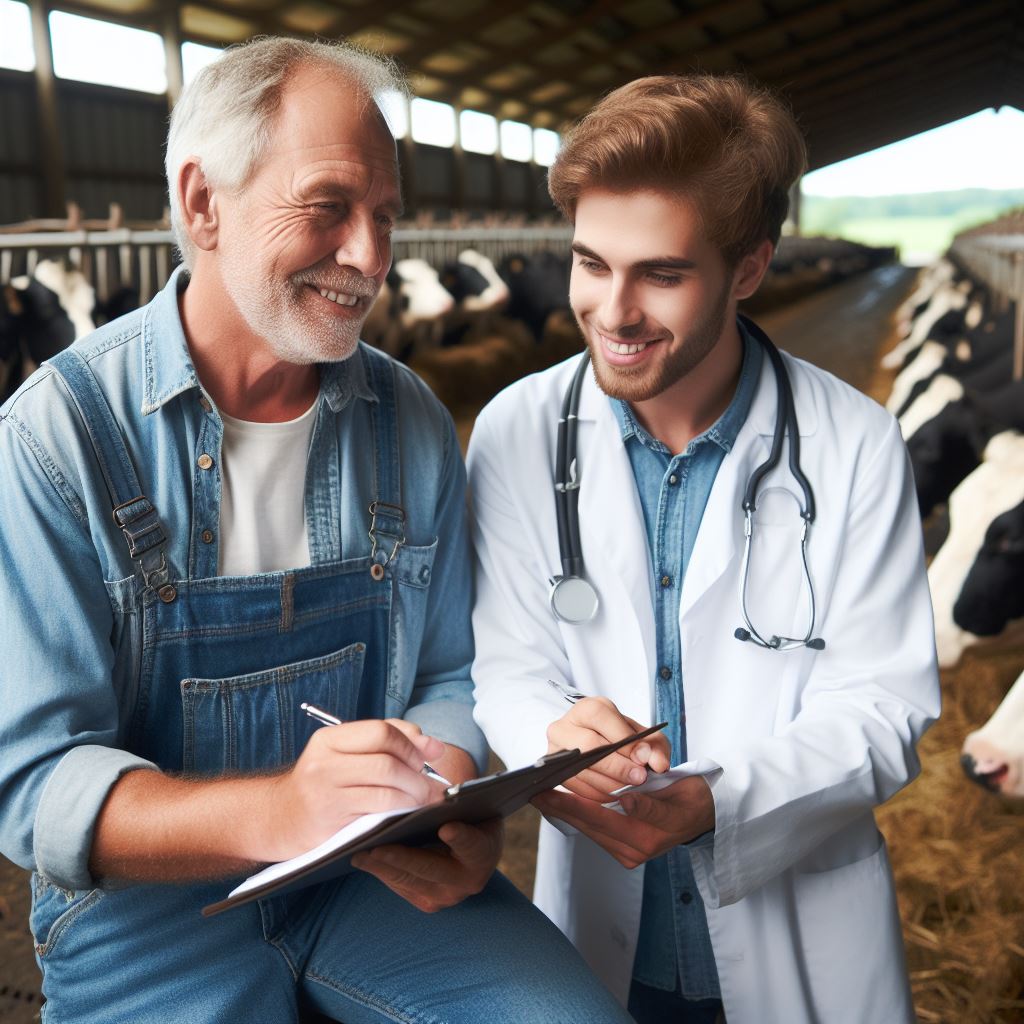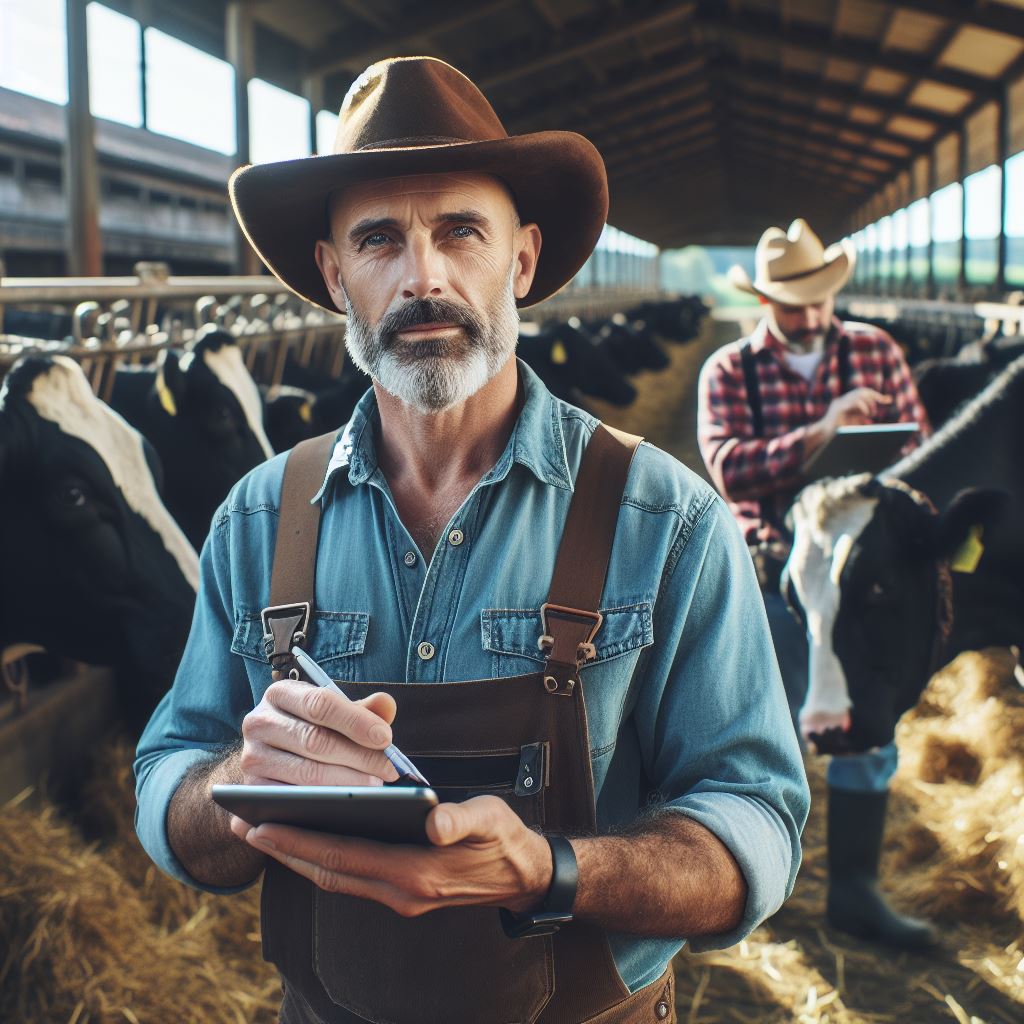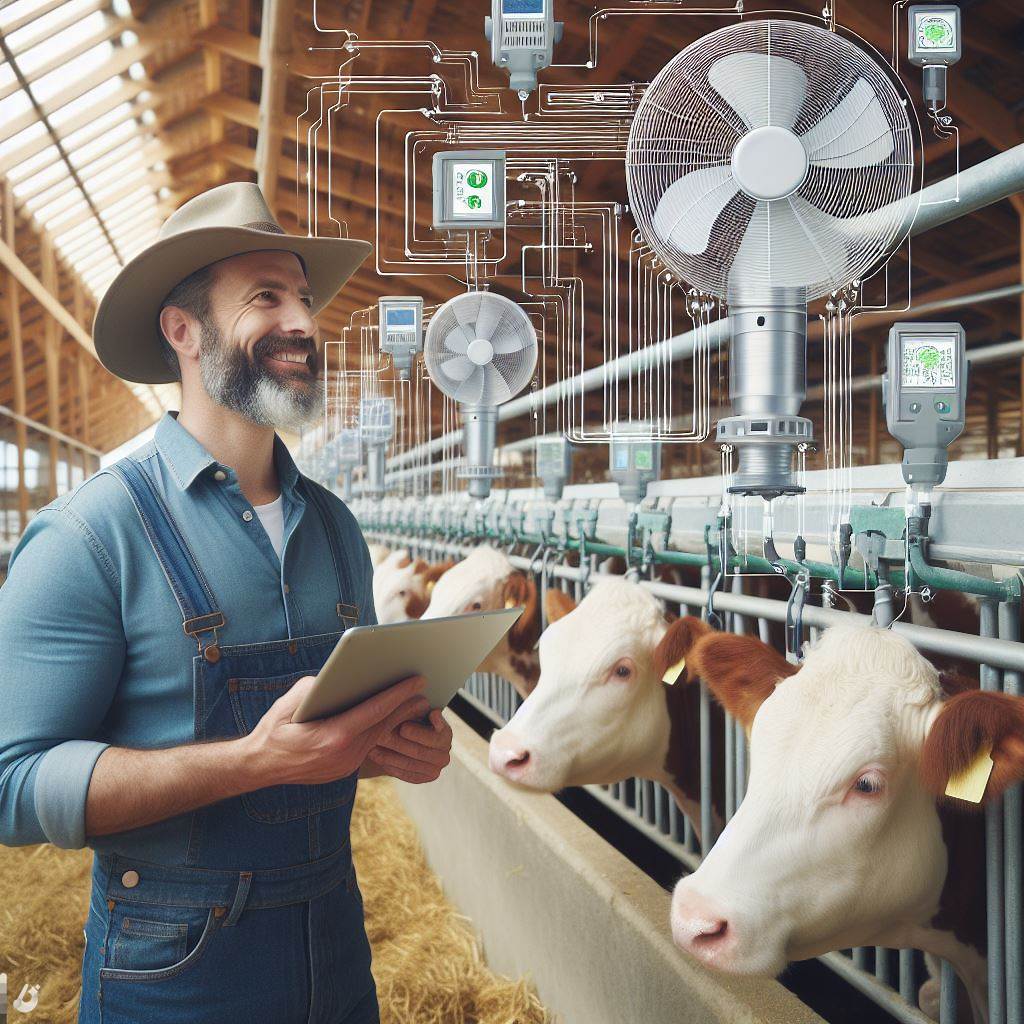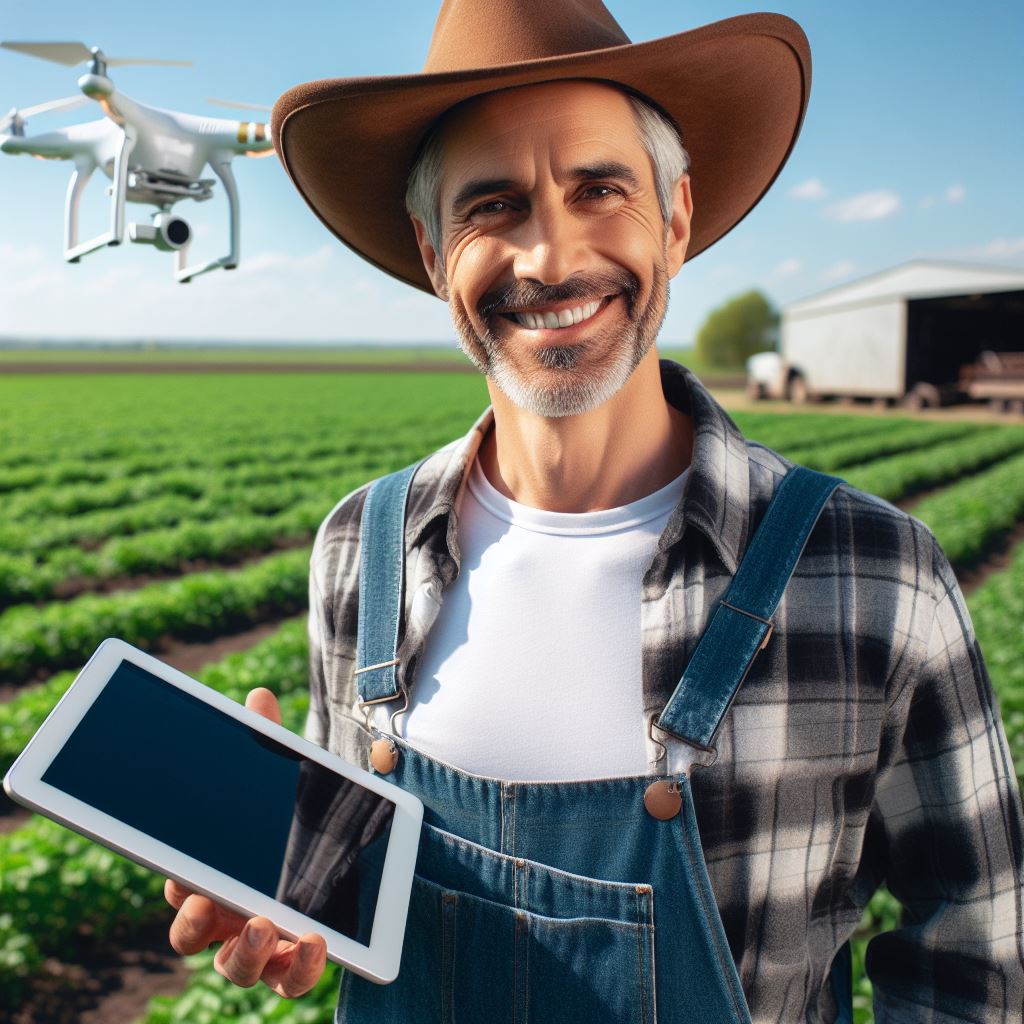Introduction
Importance of veterinary care in modern agriculture
In modern agriculture, the importance of veterinary care cannot be overstated.
It is essential for maintaining the health and well-being of animals, which directly affects the quality of products such as meat, milk, and eggs.
The well-being of animals is not only crucial for their own sake, but it also impacts the overall productivity and profitability of farms.
The role of technology in transforming veterinary care
Technology has revolutionized veterinary care, making it more efficient and effective.
Advanced diagnostic tools, such as ultrasound and digital imaging, allow for accurate and timely diagnosis of health issues.
This enables veterinarians to intervene early and provide appropriate treatment, leading to better outcomes for animals.
Furthermore, technology has improved communication and collaboration between veterinarians and farmers.
Mobile apps and telemedicine platforms enable remote consultations, reducing the need for physical travel and allowing for quick and convenient access to veterinary advice.
This is especially important in rural areas where access to veterinary services may be limited.
In addition, technology has brought innovative treatment approaches to veterinary care.
Robotics and artificial intelligence are being used to develop surgical procedures and rehabilitation techniques, enhancing the accuracy and precision of interventions.
Basically, the role of technology in veterinary care is pivotal.
It not only enhances the efficiency of diagnosis and treatment but also improves the overall well-being of animals.
As technology continues to advance, we can expect even more innovative approaches to emerge, further improving the quality of veterinary care in modern agriculture.
Technological advancements in diagnostics
Introduction to diagnostic technologies
In recent years, technological advancements have revolutionized the field of diagnostics in veterinary care.
Transform Your Agribusiness
Unlock your farm's potential with expert advice tailored to your needs. Get actionable steps that drive real results.
Get StartedThese innovations have greatly improved the accuracy and efficiency of diagnosing medical conditions in animals.
Examples of modern diagnostic tools in veterinary care
Imaging technologies (MRI, ultrasound)
Imaging technologies like MRI and ultrasound have become invaluable tools in veterinary diagnostics.
These non-invasive techniques allow veterinarians to visualize the internal structures of animals, aiding in the detection of tumors, organ abnormalities, and other health issues.
Laboratory diagnostics (blood tests, microbiology, genetics)
With the advent of advanced laboratory techniques, diagnosing diseases in animals has become more precise and efficient.
Blood tests can now quickly identify markers of various health conditions, while microbiology and genetics allow for the detection of specific pathogens and genetic abnormalities.
Wearable sensors and monitoring devices
Wearable sensors and monitoring devices have emerged as a promising technology in veterinary care.
These devices can be attached to animals’ collars or bodies to track vital signs, activity levels, and behavior patterns.
This real-time data enables veterinarians to notice early warning signs and intervene promptly.
In short, the integration of technology in veterinary diagnostics has revolutionized the way medical conditions are diagnosed and managed in animals.
These advancements have allowed for faster, more accurate diagnoses, leading to improved treatment outcomes for our beloved pets.
Read: Sensor Tech in Livestock Care: An Insight
Innovations in treatment methods
Introduction to advanced treatment approaches
The field of veterinary care has witnessed significant advancements in treatment methods, revolutionizing the way animals are diagnosed and treated.
Gone are the days when traditional approaches were the only options available for veterinarians.
With the advent of technology, modern treatment approaches have emerged, offering more precise and efficient solutions.
These advanced treatment approaches encompass a wide range of technologies and techniques that have proven to be effective in improving animal health outcomes.
Examples of modern treatment technologies
Let’s explore some examples of modern treatment technologies that have transformed veterinary care:
- Minimally invasive surgeries and robotic-assisted procedures: Just like in human medicine, veterinarians now have access to minimally invasive surgical techniques.
- Laser therapy and regenerative medicine: Laser therapy is a non-invasive treatment option that promotes tissue repair and reduces pain and inflammation in animals.
- Targeted drug delivery systems: Precision medicine has made its way into veterinary care, allowing veterinarians to administer drugs with a high degree of accuracy.
These examples represent just a fraction of the innovative treatment approaches available in veterinary care.
Minimally invasive surgeries and robotic-assisted procedures
Minimally invasive surgeries and robotic-assisted procedures have revolutionized the way surgeries are performed on animals.
These techniques involve using small incisions and specialized instruments to perform surgeries.
Veterinarians can now perform complex procedures with enhanced precision and reduced trauma for the animal.
Robotic-assisted surgeries, in particular, provide veterinarians with robotic tools that aid in performing delicate procedures with heightened accuracy.
Laser therapy and regenerative medicine
Laser therapy and regenerative medicine have found widespread application in veterinary care.
Laser therapy is utilized for various conditions, including wound healing, pain management, and arthritis treatment.
Moreover, regenerative medicine techniques such as stem cell therapy offer promising treatment options for conditions like orthopedic injuries and degenerative diseases.
Showcase Your Farming Business
Publish your professional farming services profile on our blog for a one-time fee of $200 and reach a dedicated audience of farmers and agribusiness owners.
Publish Your ProfileTargeted drug delivery systems
Another advancement in treatment methods is the development of targeted drug delivery systems.
These systems allow veterinarians to deliver medications directly to the affected area, minimizing side effects and improving efficacy.
With targeted drug delivery, veterinarians can treat conditions like cancer, allergies, and joint diseases more effectively, ensuring better outcomes for their animal patients.
In conclusion, veterinary care has seen remarkable advancements in treatment methods.
Modern approaches such as minimally invasive surgeries, laser therapy, regenerative medicine, and targeted drug delivery systems have revolutionized the field.
These innovations offer veterinarians more precise tools and techniques, leading to improved outcomes and a higher quality of life for animal patients.
As technology continues to evolve, we can expect further breakthroughs in veterinary care, ultimately benefiting both animals and their dedicated caretakers.
Read: Livestock Genetics: Tech-Driven Breeding
Digitalization in veterinary record keeping
Importance of proper record keeping in veterinary care
- Proper record keeping is vital in veterinary care for accurate patient history and diagnosis.
- It provides crucial information about treatments, medications, and previous illnesses.
- This enables veterinarians to make informed decisions and provide better care for animals.
- Accurate records also help in tracking the progress of ongoing treatments and monitoring any changes.
- It improves communication and collaboration between veterinary teams and specialists.
- This ensures seamless continuity of care and prevents any gaps in treatment.
Electronic medical records (EMRs) and their advantages
- The shift towards electronic medical records has revolutionized veterinary care.
- EMRs allow for easy storage, retrieval, and sharing of patient information.
- They eliminate the need for physical records, reducing paperwork and clutter.
- EMRs are more secure and less prone to loss or damage compared to paper records.
- They can be accessed remotely, allowing veterinarians to review records from anywhere.
- With EMRs, it becomes easier to analyze and evaluate data for research and statistical purposes.
- Electronic records also facilitate integration with diagnostic equipment for faster and accurate results.
- They improve efficiency, saving time and resources that can be redirected towards patient care.
Utilization of cloud-based platforms for data storage and accessibility
- Cloud-based platforms offer numerous advantages for veterinary record keeping.
- They provide secure and scalable storage solutions without the need for physical infrastructure.
- Cloud platforms allow real-time access to records, even from multiple locations.
- This enhances collaboration among veterinary teams, regardless of geographical barriers.
- Cloud storage is cost-effective, eliminating the need for local servers and maintenance.
- It provides automatic backups and ensures data integrity and disaster recovery.
- Cloud platforms also offer integration with other veterinary software and tools, streamlining workflows.
- Accessibility from various devices such as smartphones and tablets improves convenience and flexibility.
Generally, digitalization in veterinary record keeping has significant benefits for both veterinarians and animals.
Proper record keeping ensures accurate diagnosis, continuity of care, and collaboration among veterinary teams.
Electronic medical records simplify storage, retrieval, and sharing of patient information, enhancing efficiency and security.
Cloud-based platforms enable real-time access, remote collaboration, and cost-effective storage solutions.
Embracing modern approaches in record keeping is crucial for improving veterinary care and overall animal welfare.
Read: IoT in Agriculture: Livestock Applications
Telemedicine and remote consultations
Overview of telemedicine in veterinary care
Telemedicine is an emerging approach that allows veterinarians to provide remote healthcare services.
It involves the use of technology, such as video conferencing and digital imaging, to diagnose and treat animals.
Telemedicine offers convenience for pet owners who can access veterinary care without leaving their homes.
It also enables veterinarians to reach a larger number of patients, including those in remote areas.
Benefits and challenges of remote consultations
- Remote consultations save time and reduce stress for both the pet and the owner.
- They eliminate the need for travel and waiting rooms, making the experience more comfortable and efficient.
- Telemedicine also allows veterinarians to collaborate with specialists worldwide for complex cases.
- However, challenges like the inability to perform physical examinations and limited scope for treatment exist.
Examples of telemedicine platforms and applications for veterinarians
- Veterinary-specific telemedicine platforms like TeleVet and VetNOW provide video consultations and secure medical records.
- The American Veterinary Medical Association (AVMA) has guidelines on using telemedicine for veterinary care.
- Many veterinary schools have integrated telemedicine into their curriculum to train future veterinarians.
- Remote monitoring apps like Felcana and PetPace help track vital signs and detect potential health issues.
- Nature’s Vet Digital Pet Health is an online platform that offers various veterinary services remotely.
Essentially, telemedicine is revolutionizing veterinary care by providing remote consultations and healthcare services.
It offers various benefits including convenience for pet owners, increased accessibility to veterinary care, and collaboration opportunities for professionals.
However, challenges like the lack of physical exams and limited treatment options need to be addressed.
With the emergence of veterinary-specific telemedicine platforms and applications, remote consultations are becoming more effective and widespread in the field of veterinary care.
Read: GPS Tracking: Transforming Herd Management

Precision Livestock Farming and Animal Monitoring
Introduction to Precision Livestock Farming
- Precision Livestock Farming involves using advanced technologies to improve livestock management.
- It encompasses various aspects like monitoring animal health, behavior, and optimizing their environment.
- This approach enables farmers to make data-driven decisions and improve overall productivity.
- Precision Livestock Farming utilizes modern technologies such as Internet of Things (IoT) devices.
- These devices collect real-time data and provide insights into the animals’ conditions.
Monitoring animal health and behavior through IoT devices
- IoT devices, such as wearable sensors and RFID tags, enable continuous monitoring of animals.
- These devices can measure vital signs, activity levels, and even detect early signs of disease.
- Data collected by IoT devices is transmitted to a centralized system for analysis.
- Veterinarians and farmers can access this data remotely and monitor the animals’ health and behavior.
- Early detection of health issues allows for prompt intervention, reducing the risk of disease spread.
Application of data analytics and machine learning in livestock management
- Data analytics and machine learning algorithms can analyze large volumes of data collected from animals.
- These algorithms can identify patterns, predict animal behavior, and detect potential health problems.
- With machine learning, the system can learn from past data and improve its accuracy over time.
- Monitoring systems can provide real-time alerts for abnormal behavior or health indicators.
- By utilizing these technologies, farmers can optimize their livestock management strategies and improve productivity.
In general, precision livestock farming and animal monitoring have revolutionized the way farmers manage their livestock.
Using IoT devices and data analytics, farmers can have real-time insights into their animals’ health and behavior.
This enables them to make proactive decisions and prevent potential issues before they escalate.
By embracing these modern approaches, the veterinary care industry is transitioning towards a more efficient and sustainable future.
Ethical considerations and limitations of technology in veterinary care
Ethical dilemmas related to advanced technology
As technology continues to advance in veterinary care, ethical considerations arise regarding its use.
One ethical dilemma involves the use of advanced imaging techniques, such as MRI or CT scans, on animals.
These imaging techniques provide valuable diagnostic information but may require anesthesia, which poses risks to the patient.
Veterinarians must weigh the potential benefits of this technology against the potential harm and stress it may cause to animals.
Another ethical dilemma arises with the use of genetic testing in veterinary practice.
While genetic testing can provide valuable information about an animal’s health and predispositions, it also raises privacy concerns.
Animal owners may face difficult decisions about whether to obtain genetic testing for their pets due to potential discrimination or stigmatization.
Furthermore, the use of genetic testing may reveal information about an animal’s future health problems, which can be challenging for both owners and veterinarians.
Limitations and challenges in implementing tech-based veterinary care
Despite its promise, technology in veterinary care faces several limitations and challenges in its implementation.
One limitation is the cost associated with acquiring and maintaining advanced medical equipment and software.
Smaller veterinary practices with limited resources may struggle to invest in the necessary technology.
Another challenge is the learning curve associated with adopting new technology.
Veterinarians and support staff must receive proper training to effectively utilize tech-based tools in their practice.
Furthermore, some veterinarians may be resistant to change or hesitant to embrace new technology, hampering its widespread adoption.
Another limitation is the potential for technology to create a barrier between the veterinarian and the animal.
While technology offers many benefits, it cannot replace the importance of hands-on examination and direct interaction with the animal.
Importance of maintaining a balance between technology and hands-on care
While technology can enhance veterinary care, it is crucial to maintain a balance between technology and hands-on care.
Showcase Your Farming Business
Publish your professional farming services profile on our blog for a one-time fee of $200 and reach a dedicated audience of farmers and agribusiness owners.
Publish Your ProfileDirect physical examination and observation are essential components of providing comprehensive veterinary care.
Technology should be used as a complementary tool to assist in diagnosis and treatment, rather than a replacement for traditional veterinary skills.
Additionally, maintaining a personal connection with animal owners is vital, and technology should not overshadow the importance of communication and empathy.
Veterinarians must ensure that technology does not compromise the quality of care delivered or diminish the human-animal bond.
By striking a balance between technology and hands-on care, veterinarians can provide the best possible care for their animal patients while upholding ethical standards.
In essence, the integration of technology in veterinary care brings both ethical considerations and limitations. Addressing ethical dilemmas, such as anesthesia use and genetic testing, is crucial. Implementation challenges, like cost and resistance to change, must be overcome. Furthermore, it is essential to maintain a balance between technology and hands-on care to provide the best possible care for animal patients.
Conclusion
Recap of modern approaches in veterinary care
Throughout this blog post, we have explored the various modern approaches in veterinary care.
From telemedicine and virtual consultations to wearable devices and artificial intelligence, technology has revolutionized how veterinarians provide care to animals.
These advancements have made it possible for pet owners to access veterinary services more conveniently and for veterinarians to diagnose and treat animals efficiently.
Optimism for the future of technology in improving veterinary practices
The future of technology in veterinary care looks bright.
With ongoing advancements and innovations, we can expect even more sophisticated tools and systems to enhance the quality of care for animals.
From improved diagnostic accuracy to remote monitoring and personalized treatment plans, technology holds immense potential to revolutionize veterinary practices further.
Encouragement for veterinarians to embrace technological advancements
To keep up with the evolving landscape of veterinary care, it is crucial for veterinarians to embrace technological advancements.
The integration of technology into daily practice can lead to better patient outcomes, increased efficiency, and improved client satisfaction.
By staying open-minded and willing to learn, veterinarians can leverage technology to provide the best possible care for their patients.
In a nutshell, technology has become an integral part of veterinary care, offering numerous benefits and opportunities for improvement.
As we move forward, it is essential for veterinarians to adapt and embrace technology in their practices, ultimately enhancing the well-being of animals and strengthening the bond between humans and their beloved pets.
The future of veterinary care is exciting, and by harnessing the power of technology, we can continue to advance the field and provide exceptional care for our furry friends.




